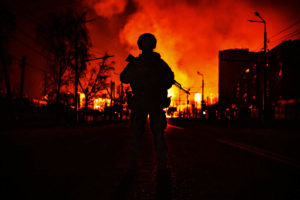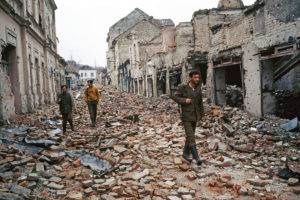Nothing was more predictable about this most predictable of wars than the certain failure of Putin’s Coup de Main invasion to seize Kyiv and conquer Ukraine in one fell swoop. And yet its success was confidently predicted by Russia’s FSB domestic security service, which, instead of the SVR foreign intelligence, was given the task of sustaining the fiction that Ukraine is Russian.
Perhaps it is not strange that Putin, himself a former FSB officer, did not question this reckless optimism. He knew that the CIA fully agreed with the FSB estimate, as did the German Bundesnachrichtendienst (BDN) and the French Direction du Renseignement Militaire (DRM).
The latter induced President Emmanuel Macron to rush to Moscow and Kyiv to avert Ukraine’s imminent downfall by offering last-minute concessions to Putin. But the BND’s error had far graver consequences: told that it was impossible to stop Russia’s swift conquest, German chancellor Olaf Scholz refused to send weapons to Ukraine, refused to allow Estonia to send 122mm howitzers originally received from Germany, refused to rule out restricting its use of the Nord Stream 2 gas pipeline, and refused to allocate funds to rehabilitate Germany’s sadly diminished armed forces. Since Putin is especially attentive to German politics, this served as a strong green light for his war.
As for the CIA’s totally wrong assessment, it had still more serious consequences. Acting under the impression that the Russians would swiftly conquer Ukraine, the White House chose to evacuate the US Embassy in Kyiv instead of rushing in weapons that would only become Russia’s booty. The demoralising effect was amplified as other Western diplomats followed suit and fled.
The failure to dissuade Putin, then, was an intelligence failure — but this is something that only requires the resolve of 51 Senators and one President to fix. By contrast, Russia’s war-making capacity has failed at every level: in the quality of individual and unit tactical combat, in operational capacity, and, most egregiously, at the level of theatre strategy (the deployment of forces over the territory). The attempt to conquer Kyiv with an endless double column of armoured vehicles advancing on a single vector meant that every act of Ukrainian resistance generated cascading stop-and-go delays that emptied out fuel tanks.
The most important tactical failure came right at the start. In the pre-dawn hours of the war on February 24, elite “air assault” infantry proved incapable of executing the key mission of the entire invasion. This was the Coup de Main that was to secure the Antonov airfield in Kyiv’s Hostomel exurb and open the way to the heart of the city, from where Zelenskyy was expected to flee in panic, leaving Ukraine’s forces leaderless and exposed. Arriving in a fleet of helicopters, the Russians duly seized the little-used airfield. Ilyushin Il-76 heavy transports were then expected to bring in many more troops to secure it, pending the arrival of mechanised units from nearby Belarus. But Zelenskyy and his ministers, who had gathered for war instead of fleeing, immediately ordered an all-out effort to counterattack the Russians with any and all forces that could reach the scene quickly.
In any normal scenario, to send odd lots of soldiers against cohesive elite units would be a sure recipe for disaster — but the ferociously determined Ukrainians overcame the Russians, who were disconcerted by having to fight hard just to survive, instead of advancing triumphantly to Kyiv’s central square, the Maidan. The IL-76 transports could not land amid the fighting, so the surviving airborne troopers had to be relieved by troops from Belarus. By that point, Ukraine’s forces were mobilised nationwide and the rapid capture of central Kyiv was out of the question.
Having blocked the Russians in Hostomel, the Ukrainians were unable to gather larger forces to crush them rapidly because they needed to send units across the country — from Kyiv and Kharkiv all the way round to Mikolaiv and Odessa. But by then the crucial fact had been established: the Russian airborne troopers in Hostomel were not tactically superior as professional elite troops should have been. The subsequent weeks of war have shown that the same was true of Russia’s tank crews, mechanised infantry and the artillery units that pounded towns and cities. Whether it was down to inattentive officers, perhaps distracted by business opportunities on the side, or because of inadequate supplies of fuel and ammunition, almost all Russia’s troops were badly undertrained, and therefore tactically inept.
Russian tactical incapacity also magnified the consequences of another surprise of this war: the emergence of super-empowered infantry that can destroy main battle tanks and knock helicopters out of the sky with shoulder-launched missiles, thereby regaining its long-lost role as the Queen of the battlefield. By 1943, the rocket-launcher M1A1 — nicknamed the “bazooka” — allowed heroic and very lucky infantrymen to occasionally destroy tanks; by 1955, the French produced wire-guided missiles that could destroy tanks if shielded from artillery, smokescreens or gunners on the hunt for them. But neither weapon could seriously impede armoured operations given normal artillery covering fires.
Now it is different. With today’s missiles, soldiers can reliably destroy tanks and low-flying helicopters with shoulder-launched missiles that need only be pointed at the target once — while still retaining the infantry’s ancient advantages of economy, of abundance, and its ability to find cover far more easily than mechanised forces.
Russian army chiefs must have missed this tactical shift — not because they are still focused on re-fighting the last war, but because, just like their American counterparts, they were hypnotised by the trendy next war. This was meant to be fought with “post-modern information warfare”, or hybrid warfare, or “4th Generation warfare ”— all so much more sophisticated, more advanced, and more high-tech than the old-fashioned “kinetic” warfare fought by blokes shooting at each other. It must have come as a big shock to Russia’s generals when Ukrainian soldiers could not be persuaded to surrender by sending menacing messages to their smartphones.
But now that the Ukrainians have gone on the offensive, they have lost their key advantage of remaining under cover while firing at exposed advancing enemies. They need armoured vehicles to avoid being held up by Russian fire, but so far they have received only a handful from the Czechs and Germans. What happens next in this war will very largely depend on the quantity and quality of the armoured vehicles friendly countries are willing to hand over to the Ukrainians. There is certainly no shortage of them in Europe, where shrunken armies have placed thousands of armoured vehicles in storage, ranging from thinly protected ten-ton M.113 troops carriers that are still better than nothing, to full-weight battle tanks with guns that can still be formidable if supplied with up-to-date rounds.
And this is just one more challenge in a war that will continue until Putin is willing to cut his losses and accept the one thing that Zelenskyy can give him: a promise that he will not apply for Nato membership. As to why the stalwart Zelenskyy has indicated he will do this, declaring that Ukraine’s model will instead be self-sufficient Israel, the answer is obvious: instead of strengthening its members, in recent times Nato has provided an alibi for their unilateral disarmament, which persisted even after Russia’s annexation of Abkhazia, South Ossetia, and Crimea. Not only have armies shrunk, but their training is more ceremonial than functional, as became painfully evident when supposedly well-trained units were sent to Iraq and Afghanistan.
In the years since Putin ended the post-1945 peace by seizing Crimea, only two European countries have acted to strengthen their armed forces: Finland in diverse ways, and Sweden whose government promptly reintroduced conscription to rebuild a strong army — neither of which are Nato members. Poland, which is a Nato member, contrives to have an army of 60,000 with its 37 million inhabitants, as opposed to Finland’s 280,000 on mobilisation with one sixth of the population.
As it happens, I was in Warsaw in November 2021, admittedly long ago, before the war. Upon asking the Presidential adviser whom I met for dinner why it was that Poland did not have a remotely commensurate army to defend itself given that it was next to Russia, he cited Nato’s security guarantee, which allowed Poland to spend its defence funds on what really mattered: a frigate in the Baltic (admittedly an excellent target for torpedoes or missiles), fancy helicopters for Polish units sent on peace-keeping missions, and the elaborate peaked hats of Polish officers. No wonder Zelenskyy gave up on Nato membership so easily.
The very great problem we all face — Americans, Europeans, Ukrainians and even Russians — is how to end this new European civil war. Now we are all stuck: Putin cannot leave the roulette table without the Donetsk and Luhansk regions as his prize, but Zelenskyy does not have the authority to give away Ukrainian territory even if he wanted to.
So here is my modest proposal: a referendum in each of the regions that requires a total ceasefire and which itself implies the renunciation of any further claims on Ukraine. Putin’s invasion failed within hours of being launched. Almost 50 days later, it is time for it to end.
Disclaimer
Some of the posts we share are controversial and we do not necessarily agree with them in the whole extend. Sometimes we agree with the content or part of it but we do not agree with the narration or language. Nevertheless we find them somehow interesting, valuable and/or informative or we share them, because we strongly believe in freedom of speech, free press and journalism. We strongly encourage you to have a critical approach to all the content, do your own research and analysis to build your own opinion.
We would be glad to have your feedback.
Source: UnHerd Read the original article here: https://unherd.com




